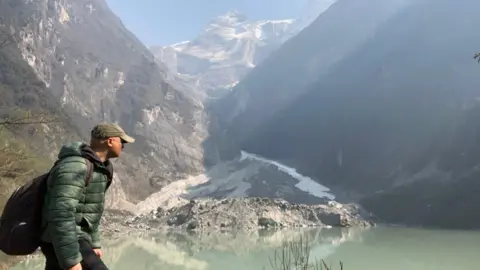The majestic Himalayas, renowned for their sprawling peaks and breathtaking beauty, are becoming increasingly veiled by a persistent haze that obscures their view. An environment correspondent, Navin Singh Khadka, shares his experiences and insights regarding this concerning trend in a recent article published by BBC World Service.
Growing up in the capital city of Nepal, Kathmandu, Khadka recalls how the Himalayas were a constant in his life, providing panoramic vistas of some of the highest peaks on Earth. However, during his visits back home, he finds himself increasingly disappointed in his attempts to admire the grandeur of the mountains. The primary reason for this shift is the severe air pollution that now blankets the region, creating a persistent haze that is particularly noticeable during what were once considered the best months for clear skies—spring and autumn.
In April, for instance, Khadka notes an instance where his international flight had to circle Kathmandu’s airport nearly twenty times before landing due to reduced visibility caused by haze. Once on the ground, he found no escape from the haze, not even from a hotel’s higher vantage point that would typically offer majestic views of the mountains. Tragically, even popular viewpoints such as Nagarkot had become synonymous with haze, leaving hotel operators like Yogendra Shakya disheartened as they rebrand their businesses away from mountain views towards historical and cultural offerings.
The trend of disappearing Himalayan views isn’t limited to Kathmandu; trekking in the famed Annapurna region has also yielded disappointing results, as visitors find themselves unable to view the peaks both up close and from afar. This growing sense of despair amongst locals and tourists alike is indicative of a larger trend affecting the entire Himalayan region. The detrimental conditions that have plagued visibility are largely attributed to a combination of dust and smoke from extensive pollution sources, including vehicle emissions, industrial activities, and the frequent burning of waste and agricultural residues.
Climate change compounds the situation, as the dry season in the Himalayas is extending, with hazy conditions becoming increasingly pronounced and lasting longer into the year. Traditionally, the March to May and October to November months were ideal for trekking and tourism due to clearer skies, but current trends foretell a disheartening future. As Khadka articulates, temperatures are rising, less rain is falling, and pollution levels are climbing, which drastically diminishes visibility and can obstruct clear views of the mountains as early as December.
This unsettling development has made a considerable impact on tourism, as evidenced by reports of a 40% decline in business for trekking guides like Lucky Chhetri due to hazy conditions obstructing mountain views. Tourists are expressing their disappointment over the diminishing visibility, with individuals like John Carrol lamenting that conditions have sharply deteriorated in only the last decade. Local trekking operators, represented by figures like Krishna KC, emphasize that many are facing potential occupational shifts as consistent mountain sightings, crucial for business, become a rarity.
Further exacerbating the problem, the Indian side of the Himalayas is experiencing similar challenges—the haze returning quicker and being denser than in years past. As noted by Malika Virdi, head of a tourism business in Uttarakhand, the weather is unpredictable, making it harder for tourists to behold the iconic mountain range. Similarly, even in Pakistan, once-pristine views of the mountains are becoming clouded by persistent haze.
Experts indicate that the Himalayan region is arguably the most adversely affected mountain range globally, situated as it is within a densely populated area riddled with pollution. The trend of increasing haze and dust storms poses grave implications for public health and tourism activity alike, with air quality issues contributing to frequent travel disruptions and even school closures.
The uphill battle against air pollution in South Asia is ongoing due to various factors, including industrial emissions, construction dust, and the inheritance of a longer dry season that has aggravated wilderness fires. As the region’s air is laden with harmful particulates, the resulting haze increasingly effects not only the visibility of the Himalayas but also the financial viability of tourism-dependent communities.
With these fundamental changes threatening both environmental integrity and economic stability, there’s a palpable sense of urgency amongst locals, tourists, and experts alike to raise awareness and mitigate the pollution that continues to conceal the breathtaking Himalayas. For now, the views of these magnificent mountains may remain confined to memories, photographs, and postcards rather than the realities that they once were.



